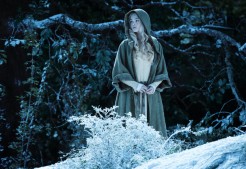My nerd-heart is absolutely leaping up and down right now. Mary Shelley has long been a favorite of mine—not least because she penned Frankenstein, one of the most enduring pieces of monster literature and a cornerstone of the Gothic horror genre. She’s also just a fascinating woman. And this year, we’ll get not one, but two Mary Shelley films, one that focuses on the writing and publication of Frankenstein and another on her relationship with husband Percy Bysshe Shelley.
The first of the Shelley films due out this year stars Elle Fanning and will be titled A Storm in the Stars. The biopic is intended to show the relationship between Mary and Percy Bysshe Shelley, including its tempestuous beginning. Haiffa Al Mansour, (Wadja) the first female Saudi Arabian director, will direct a script written by Emma Jensen.
And just announced is Sophie Turner’s (HBO Game of Thrones, Sansa Stark) involvement in another Mary Shelley project. She has just been cast as writer Mary Shelley in Mary Shelley’s Monster. The film will be directed by Coky Giedroyc; her work includes American Horror Story and Penny Dreadful. (Yes, we’re getting one of our PD directors on this film—horray!) Mary Shelley’s Monster was written by Deborah Baxton. It tackles a Faustian tale of Mary’s monster alter-ego as she writes Frankenstein. Taissa Farmiga (American Horror Story) is set to play Claire alongside Jeremy Irvine (War Horse) as Percy Bysshe Shelley.
Mary Shelley is the daughter of feminist Mary Wollstonecraft, who penned A Vindication of the Rights of Woman, a pivotal early text of the feminist movement. But Mary Shelley didn’t know her mother—she died in 1797, less than 2 weeks after giving birth to Shelley. And the legacy that Wollstonecraft left behind was a complex one–she was both celebrated and condemned for her promiscuity, for her ideas about femininity, and for her genius. Shelley’s father was William Godwin, a mostly-political writer with anarchist philosophies. Left to care for Shelley and her sister, Fanny Imlay (Wollstonecraft’s daughter from an affair), William began searching for a wife. In the meantime, he took great interest in Mary’s education, and so her early childhood education was well supervised. He remarried in 1801; Mary’s stepmother didn’t seem to like her much: her stepbrother, Charles, and stepsister, Jane (who later changed her name to Claire), were formally educated while Mary was left at home; Mary’s access to her father was limited; and Mary’s mail was often opened by the new Mrs. Godwin.
Despite her lack of formal education, Mary Shelley listened to such thinkers and writers as Charles Lamb, Samuel Taylor Coleridge, and William Wordsworth, friends of her father’s, when they visited her home. They were often interested in her, the product of two such forward intellectuals. She also had access to her father’s rather extensive library. Mary grew up reading, and early on she turned to writing, too. At the age of 10, she had a children’s story published by her father’s company, a children’s book company that was the family’s livelihood when Godwin’s books didn’t sell well.
In 1812, Mary met Percy Bysshe Shelley and his then-wife, Harriet Westbrook Shelley. Over the course of many evenings dining with the Godwins and talking with Mary, Percy and Mary fell in love. It was only after his attempted suicide in 1814 that Mary was truly convinced of this, though, and she and Claire fled with him to France shortly after. In 1816, Claire had an affair with George Gordon, Lord Byron, and it was during a visit to his home that Mary Shelley came up with the inklings of what would become Frankenstein. One evening, the group was driven inside by rain, and they began reading ghost stories. That night, as a sort of game, they were all supposed to write their own horror tale. Mary’s was to be the beginning of her novel. She was 19. And the world was never to be quite the same.








What a fascinating story! Thanks for sharing. 🙂
LikeLike
You’re welcome! Shelley is one of my favorites, so I’m interested in the resurgence of her work and information about her life.
LikeLike
Now I am interested in seeing Frankenstein again!
LikeLiked by 1 person
Pingback: The Great Villain Blogathon: Frankenstein and His Monster | Part Time Monster
Pingback: Blogging A to Z Day 18: Penny Dreadful | Sourcerer